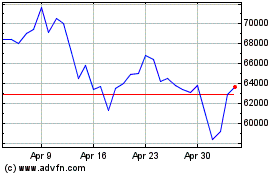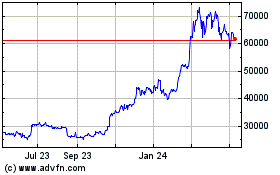Despite Bitcoin Crash, Bitwise Predicts ‘Violent’ Surge Amid Trump’s Tariffs
February 03 2025 - 3:30AM
NEWSBTC
The Bitcoin price sank by more than 13.5% over the weekend,
dropping as low as $91,201 on Binance. The sell-off followed US
President Donald Trump’s announcement of new trade tariffs. The
administration levied a 25% tariff on most imports from Canada and
Mexico, added a 10% tax on Chinese goods, and imposed a 10% tariff
on Canadian energy resources. While market observers typically view
such aggressive moves as a negative for risk assets, one prominent
voice at Bitwise Invest sees a wildly different scenario,
predicting that these tariffs could fuel a “violent” long-term
rally in Bitcoin. Why Tariffs May Supercharge Bitcoin Jeff Park,
Head of Alpha Strategies at Bitwise Invest, argues that these
tariffs cannot be understood simply as a response to trade
imbalances but should be viewed against the broader backdrop of the
so-called Triffin dilemma. In Park’s words, “The US wants to keep
its ability to borrow cheaply, but rid its structural overvaluation
and constant trade deficits—enter tariffs.” Related Reading:
Bitcoin Price Is Trading In This Bearish Flag — What’s The Downside
Target? He suggests that, by using tariffs as a bargaining chip,
the White House is looking to create a new multi-lateral
agreement—akin to a “Plaza Accord 2.0”—aimed at weakening the US
dollar. This would potentially oblige foreign governments to reduce
their US dollar reserves or to hold longer-duration Treasuries,
thereby keeping yields low without officially enacting yield curve
control. Park also ties this strategy to the president’s personal
incentives. He believes Trump’s “#1 goal” is to drive down the
10-year Treasury yield, in part because cheaper long-term financing
would benefit real estate markets. According to Park, such a push
for lower yields dovetails with a deliberate move to weaken the
dollar—two conditions that, in his view, create a perfect
environment for Bitcoin to flourish. “The asset to own therefore is
Bitcoin. In a world of weaker dollar and weaker US rates, something
broken pundits will tell you is impossible (because they can’t
model statecraft), risk assets in the US will fly through the roof
beyond your wildest imagination, for it is likely a giant tax cut
will have to accompany the higher costs borne by the loss of
comparative advantage,” Park writes. His thesis is that the “online
and onchain” nature of today’s economy will funnel frustrated
citizens across the globe toward alternative stores of value—namely
Bitcoin. He believes both sides of any prolonged tariff war will
discover that BTC offers a refuge from the fallout, leading to what
he describes as a much higher price trajectory. Related Reading:
Analyst Explains Bitcoin’s Path To $150,000 – Details “So while
both sides of the trade imbalance equation will want Bitcoin for
two different reasons, the end result is the same: higher,
violently faster—for we are at war. TLDR: You simply have not yet
grasped how amazing a sustained tariff war is going to be for
Bitcoin in the long run,” Park claims. Tariffs As A Risk Asset Drag
Not all analysts share Park’s optimism. Alex Krüger, an economist
and trader from Argentina, disagrees with the notion that tariffs
of this magnitude inherently favor Bitcoin. He warned that “Bitcoin
is mainly a risk asset.” He added: Tariffs this aggressive are very
negative for risk assets. And the economy will take a hit. The
tariffs announced are considerably worse than what was expected by
the market, as gradual tariffs or delayed implementation were seen
as alternatives. So the S&P futures will open deeply in the red
tonight and flush.” In Krüger’s view, Bitcoin remains a high-beta
asset often correlated with equity markets. When a major macro
shock—like a sudden hike in tariffs—hits, investors typically
rotate into safe havens rather than riskier holdings such as stocks
or cryptocurrencies. He pointed out that the sell-off in crypto
over the weekend might be explained by the market reacting to an
“unexpectedly harsh” tariff announcement. “The hope for crypto is
that it has already dropped a lot in anticipation,” Krüger
observed, hinting that digital assets may find a local bottom if
the initial shock has been fully absorbed. However, he emphasized
the persistent uncertainty ahead, including the possibility of
retaliation by targeted nations. A swift resolution to the trade
dispute could trigger a bounce, whereas an escalation could deepen
market jitters. Krüger also cautioned that the Federal Reserve
might turn hawkish if tariffs stoke inflation—an outcome that
rarely bodes well for high-growth or risk-prone assets. Still, he
hasn’t ruled out fresh all-time highs in equities later this year:
“I still don’t think the cycle top is in, and expect equity indices
to print ATHs later in the year. But the probability of being wrong
has increased. Particularly on the latter. As I said a week ago,
I’ve taken my long-term hat off. This is a traders’ market.” At
press time, BTC traded at $94,000. Featured image created with
DALL.E, chart from TradingView.com
Bitcoin (COIN:BTCUSD)
Historical Stock Chart
From Jan 2025 to Feb 2025

Bitcoin (COIN:BTCUSD)
Historical Stock Chart
From Feb 2024 to Feb 2025
